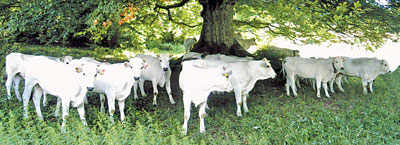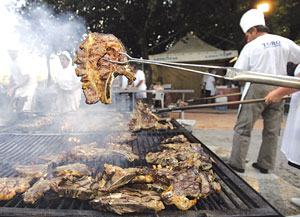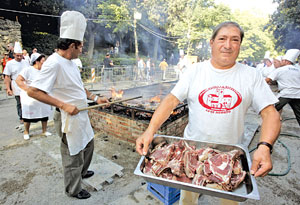Steak-lovers lick lips at Chianina comeback
Mathias Wildt
|

HERD: Chianina cows huddle under a tree in Tuscanyin. New York
restaurants compete to serve expensive, fat-rich beef, while
Japanese pamper their Wagyu cows with massages and beer to vein
the meat with as much fat as possible. But in Tuscany, where
fiorentina-style steaks are two to four fingers thick and can
weigh 1.5 kg (four pounds), the lean chianina rules the grill
for top-end foodies. Reuters
|
LIFESTYLE: Six-time Olympic champion Milo of Kroton trained by
carrying a calf on his back until it turned 4 years old. Then he ate it.
A massive wrestler from southern Italy, Milo was said to eat 18 kg
(40 lb) of meat and bread washed down with eight litres (8.4 quarts) of
wine in one sitting - 2,500 years ago.
Milo was probably devouring Chianinas, the oldest and biggest bovine
breed in the world, and now making a comeback as health-conscious
consumers turn to leaner meat that can still compete on taste with
fatter breeds.
New York restaurants compete to serve expensive, fat-rich beef, while
the Japanese pamper their Wagyu cows with massages and beer to vein the
meat with as much fat as possible.
But in Tuscany, where Fiorentina-style steaks are two to four fingers
thick and can weigh 1.5 kg (3.3 lb), the lean Chianina rules the grill
for top-end foodies.
"Nothing tastes as good as a Chianina steak," said Duccio Masetti,
39, holding a carved T-bone in front of him with two hands as juice
dribbled down his chin.
Masetti was one of thousands who thronged the Tuscan town of Cortona
for its annual mid-August Chianina fair, where 2,200 steaks were cooked
on a huge grill. The livestock breed takes its name from the Chiana
valley, which the town dominates.
|

BARBEQUE: Cooks grill chianina steaks at a barbeque in Cortona,
Italy
Reuters |
Chianina beef costs 30 euros a kg ($18.60 a lb), more than the 20
euros a kg for Italian prime beef, but a fraction of the price for Wagyu,
which can sell for 750 euros a kg ($460 a lb).
Masetti, who has driven two hours from his native Pistoia to attend
the Cortona fair every year for the past five years, also travelled to
Kobe, Japan, last year to taste Wagyu beef. He said he found it cloying
after a few bites.
"The Wagyu is great, but after a while my stomach said 'No more!'
It's like eating marzipan. Chianina is light. I can eat a kilo of it,"
Masetti said.
Chianina bulls stand 1.8 metres tall at the shoulder and weigh 1.5
tonnes. They have short, smooth white coats and short horns.
Used in ritual sacrifices by the Romans, Chianinas have also been
used to pull heavy loads over the past 1,000 years - and almost vanished
when tractors replaced them in the 1950s.
But the 1990s mad-cow disease scare sent sales of Chianina soaring as
health-conscious consumers sought meat from Chianinas, which did not
have a single case of the disease.
"The consumer nowadays is looking more and more for quality and
health guarantees," said Stefania Veltroni of the Arezzo province
Chianina consortium.
In the last 10 years, the number of farms producing Chianinas has
increased 18 percent to 1,347, with a 31 percent boost in the number of
Chianinas butchered to 42,000 a year.
Chianinas have an unsurpassed capacity for lean meat production,
according to breeders as well as Italian and Australian authorities.
|

STEAKS: A cook carries a tray of chianina steaks at the barbeque
in Cortona. Reuters |
The meat has little waste but still retains a marbling of fat in the
muscle, resulting in meat with more protein, less fat and less
cholesterol than other beef.
In the United States, they have been cross-bred with Angus to make
Chiangus cattle. In Australia and Canada, Chianinas are appreciated for
their ability to thrive in harsh weather and terrain.
The Chianina label is protected under a European Union designation of
regional quality as "Vitellone Bianco dell'Appennino Centrale", just
like Parma ham.
Under the rules of the breed's consortium in Italy, the calf must be
naturally nursed by the mother and then fed on preservative-free grass.
"That's a far cry from the 'meat machines' that are pumped full with
growth hormones so they can be butchered at 12 months and cost less than
Chianina, which needs 18-20 months to mature," said Stefano Falorni, 60,
an eighth-generation butcher.
His 300-year-old shop in Greve near Florence is famed for its
Chianina and has become a compulsory stop for foodies from Italy and
beyond. Clients include former British prime minister Tony Blair, who
likes a roast of a whole fillet, and the pop musician Paul McCartney.
Reuters |

